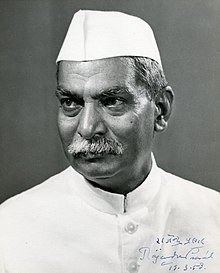
Back راجندرا براساد Arabic راجندرا براساد ARZ ৰাজেন্দ্ৰ প্ৰসাদ Assamese Rajendra Prasad AST राजेन्द्र प्रसाद AWA Racendra Prasad Azerbaijani Раджэндра Прасад Byelorussian राजेंद्र प्रसाद Bihari রাজেন্দ্র প্রসাদ Bengali/Bangla Rajendra Prasad Catalan
Rajendra Prasad | |
|---|---|
 Official portrait, 1950 | |
| 1st President of India | |
| In office 13 February 1952 – 13 May 1962 | |
| Prime Minister | Jawaharlal Nehru |
| Vice President | Sarvepalli Radhakrishnan |
| Preceded by | Himself |
| Succeeded by | Sarvepalli Radhakrishnan |
| In office 26 January 1950 – 12 February 1952 (interim) | |
| Prime Minister | Jawaharlal Nehru |
| Preceded by | Position established |
| Succeeded by | Himself |
| 1st Minister of Agriculture | |
| In office 15 August 1947 – 14 January 1948 | |
| Prime Minister | Jawaharlal Nehru |
| Preceded by | Position established |
| Succeeded by | Jairamdas Daulatram |
| President of Constituent Assembly of India | |
| In office 11 December 1946 – 24 January 1950 | |
| Prime Minister | Jawaharlal Nehru |
| Vice President | Harendra Coomar Mookerjee V. T. Krishnamachari |
| Preceded by | Sachchidananda Sinha |
| Succeeded by | Position abolished |
| Personal details | |
| Born | 3 December 1884 Ziradei, Bengal Presidency, British India (present-day Bihar, India) |
| Died | 28 February 1963 (aged 78) Patna, Bihar, India |
| Political party | Indian National Congress |
| Spouse | |
| Children | Mrityunjay Prasad (son) |
| Alma mater | University of Calcutta |
| Occupation |
|
| Awards | Bharat Ratna (1962) |
Rajendra Prasad (born Rajendra Prasad Srivastava; 3 December 1884 – 28 February 1963) was an Indian politician, lawyer, journalist and scholar who served as the first president of India from 1950 to 1962. He joined the Indian National Congress during the Indian independence movement and became a major leader from the region of Bihar and Maharashtra. A supporter of Mahatma Gandhi, Prasad was imprisoned by British authorities during the Salt Satyagraha of 1930 and the Quit India movement of 1942. After the constituent assembly 1946 elections, Prasad served as 1st Minister of Food and Agriculture in the central government from 1947 to 1948. Upon independence in 1947, Prasad was elected as President of the Constituent Assembly of India, which prepared the Constitution of India and which served as its provisional Parliament.
When India became a republic in 1950, Prasad was elected as its first president by the Constituent Assembly. As president, Prasad established a tradition for non-partisanship and independence for the office-bearer and retired from Congress party politics. Although a ceremonial head of state, Prasad encouraged the development of education in India and advised the Nehru government on several occasions. In 1957, Prasad was re-elected to the presidency, becoming the only president to serve two full terms. Prasad stayed in office for the longest term of around 12 years. Post the completion of his tenure, he quit the Congress and set up new guidelines for parliamentarians which are still followed.
© MMXXIII Rich X Search. We shall prevail. All rights reserved. Rich X Search